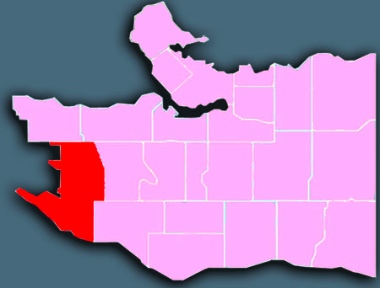 Four years ago Jonathan Bird and I posted a series on the neighbourhoods of Vancouver. We are offering them again, with demographics from the latest national census and some other updates.
Four years ago Jonathan Bird and I posted a series on the neighbourhoods of Vancouver. We are offering them again, with demographics from the latest national census and some other updates.
Dunbar-Southlands is a quiet, leafy, high-income family neighbourhood with a strong suburban, even semi-rural, ambience.
It is in the southwestern section of the city, running south from 16th Avenue all the way down to the Fraser River. On the west it is bounded by the University (of BC) Endowment Lands and Pacific Spirit Regional Park.
The eastern boundary is marked by Puget Drive and Quesnel Street (going south from 16th Avenue), Mackenzie Street (at King Edward) and Blenheim Street ( west at 41st Avenue).
Demographics
From Statistics Canada, 2016 Census, custom order for City of Vancouver Local Areas (comparative data for Census Metro Area in parentheses).
population: 21,425 19 & under: 25% (21%) aged 65+: 17% (16%)
married/common-law: 61% (57%) people living alone: 6% (11%) widows: 545 households with kids at home: 51% (39%) lone parents: 860
Moved in the past year: 14% (16%) Moved in the past 5 years: 35% (44%) Renters: 22% (36%)
Median household income: $104,450 ($72,662) All persons in low-income: 17% (14%) 17 & under in low-income: 15% (15%) 65+ in low-income: 4% (10%)
ESL: 37% (43%) mother tongues: Mandarin 16% Cantonese 7% German 2% French 1% Spanish

Peggy Scofield told the story of Dunbar through a series of interviews in this 2007 book.
Dunbar-Southlands is a low density, family-oriented neighbourhood consisting almost exclusively of owner-occupied detached houses and duplexes.
In fact, it has the city’s highest concentration of married and common-law households, as well as families with children living at home. Naturally, therefore, it has the highest percentage of residents aged 19 and under. But it also has the lowest percentage for residents aged 20 – 39. It ties with Sunset for having the city’s lowest concentration of people living alone.
With the city’s lowest percentage of renter households, the neighbourhood has the third lowest percentage of people who moved within the past five years. The median household income here is 44 percent higher than the regional figure, although many of the longtime residents are middle class retirees who bought homes decades before the neighbourhood gentrified.
Like the other westernmost neighbourhoods, the area has a notably lower percentage of ESL residents than average.
History
Archaeology confirms that the Musqueam people have been present with an astonishingly consistent culture in this area for thousands of years – at least 4,000 years at the Marpole Midden, and at least 3,500 years at the Musqueam Reserve.
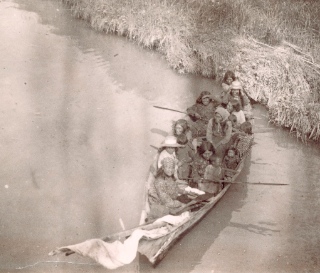
Women and children in dugout canoe on Fraser River. Photo by C.T. Dunbar about 1890. City of Vancouver Archives: AM54-S4-: In P137
Chuck Davis, in his History of Metropolitan Vancouver, notes that pioneer real estate developer Charles Trott Dunbar “arrived in Vancouver in 1888 and in 1908 was promoting development of Dunbar Heights, with lots ‘selling like hotcakes.’”
The neighbourhood was built out in the 1920s after being clearcut and burned, and as the interurban tram expanded from Kitsilano and Kerrisdale. It remained a quiet working and middle class suburb until the 1990s, when its unusually large lots made it attractive to wealthier buyers wanting to construct bigger homes.
Notable features
Musqueam land claims: This territory, like nearly all land in the province, has never been ceded to the Crown by treaty. The Musqueam people successfully prevented a condo development overtop a gravesite in the midden (east of the Dunbar area).
A controversial land swap in 2007 involving two parcels of Pacific Spirit Park, the University Golf Course and the site of River Rock Casino in Richmond underscored both the difficulty and the necessity of justly settling urban land disputes.
Musqueam claims extend well beyond the boundaries of Dunbar/UBC; the Musqueam Declaration, released in 1976, began:
We, the Musqueam people openly and publicly declare and affirm that we hold aboriginal title to our land, and aboriginal rights to exercise use of our land, the sea and fresh waters, and all their resources within that territory occupied and used by our ancestors . . .

Some development is coming, at least on the main street.
Green and quiet: Dunbar-Southlands is a community of quiet, residential streets, most of which are shaded by beautiful old trees. There are several sizeable parks (Chaldecott, Memorial West, Balaclava, Musqueam) and golf courses (Shaughnessy, Point Grey, McCleery) and even farmland, below Marine Drive. All along the western border there is easy access to trails in the University Endowment Lands.
Change is often not welcome. One example is the enormous controversy that erupted over the 51-unit supportive housing complex built on city property at 17th and Dunbar for single adults with a history of mental health issues and homeless.
Most of the tenants who moved into the building in 2011 came off the streets of west side neighbourhoods. And many of them were helped along the way by Anglican volunteers with the modestly-named Westside Anglicans Neighbourhood Ministry.
A touching article in The Vancouver Sun described them as the ‘Westside Neighbourhood Ministry of form-fillers’ because of the way Dunbar / Point Grey church members befriended homeless people and then helped them to navigate through various bureaucratic roadblocks on the way to permanent housing.
There was also major resistance to a proposal that would have seen Stong’s Market at 30th and Dunbar redeveloped as a six-storey mixed-use building. There are now some significant developments.
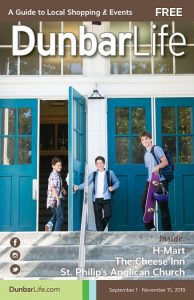 Dunbar Village runs through the middle of the area. The Dunbar Village Business Improvement Association (BIA), created in 2008, has done a good job of building on the already-strong sense of community in the area.
Dunbar Village runs through the middle of the area. The Dunbar Village Business Improvement Association (BIA), created in 2008, has done a good job of building on the already-strong sense of community in the area.
The association publishes a magazine called Dunbar Life, which “serves as a village voice and is a perfect resource for visitors to explore the area and find out the inside scoop.”
The current issue has offers a feature on St. Philip’s Anglican Church, written by the new rector Stuart Hallam; here is a brief portion:
We believe God makes herself present when people join together in community – dreaming of a new world, as some people in Scripture dreamt before us and as many people, of all faiths or none, have dreamt throughout history.
Sometimes we meet God when we pray and sing, and when we share bread and wine. Sometimes we meet God in the street, in a conversation with a stranger or when we are inspired to get together to change things . . . and sometimes we miss seeing him.
There are three distinct areas in Dunbar Village: between 16th and 19th, between King Edward and 30th, and between 38th and 41st and east along 41st.
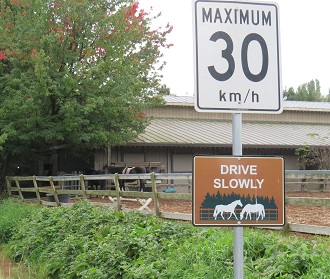 Southlands: Between Southwest Marine Drive and the Fraser River is a unique area; the land is shared by Indigenous people, wealthy landowners and golf courses. The Musqueam people live on a small portion of their traditional territory, the Musqueam Indian Reserve. They are surrounded by green space, with Shaughnessy Golf and Country Club to the west, Point Grey Golf and Country Club to the east. To the north is Musqueam Park; south is the Fraser River.
Southlands: Between Southwest Marine Drive and the Fraser River is a unique area; the land is shared by Indigenous people, wealthy landowners and golf courses. The Musqueam people live on a small portion of their traditional territory, the Musqueam Indian Reserve. They are surrounded by green space, with Shaughnessy Golf and Country Club to the west, Point Grey Golf and Country Club to the east. To the north is Musqueam Park; south is the Fraser River.
Most of the rest of the land features expensive homes and is zoned for hobby farms – every lot must have a horse barn and field! Southlands Heritage Farm is a non-profit facility for community agriculture and a farmers market.
Churches
- Canada West Presbyterian Church (Korean)
- Dunbar Heights Baptist Church
- Dunbar Evangelical Lutheran Church
-
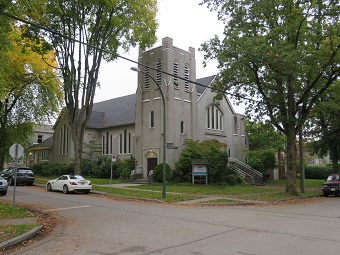
Pacific Spirit United Church is no longer used for services; members meet at their partner church in Kerrisdale.
Faith Community Christian Church
- Immaculate Conception Catholic Church
- Knox United Church
- Marineview Chapel
- Pacific Spirit United Church (formerly Dunbar Heights)
- St. Michael’s (Musqueam) Catholic Church
- St. Philip’s Anglican Church
See map.
Here are a couple of ways in which Dunbar-Southlands churches are linked to their neighbourhood:
- Knox United Church: “Constructed in 1922, Knox’s beautiful sanctuary has long been recognized by musicians for its excellent acoustics, and has been used for numerous concerts, live recordings and for television and movie productions.”
-
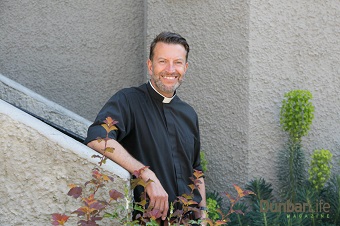
Rector Stuart Hallam wrote an article about St. Philip’s for the current issue of Dunbar Life.
Philip’s Anglican Church, on 27th, west of Dunbar Street, is involved in a number of outreach programs, including the Westside Anglicans Neighbourhood Ministry (see above), the Food Bank, Mission to Seafarers and a wide range of local and international community programs.
St. Philip’s has been offering their building to community groups for a long time; I (Flyn) took part in Cubs there when I was a boy) – though I can’t remember having been granted access to their rather unique two-lane bowling alley in the basement.
Further information
- The City has a Dunbar-Southlands page.
- Dunbar Residents Association
- Dunbar Village Business Association
- Dunbar Life is “a guide to local shopping and events.”
